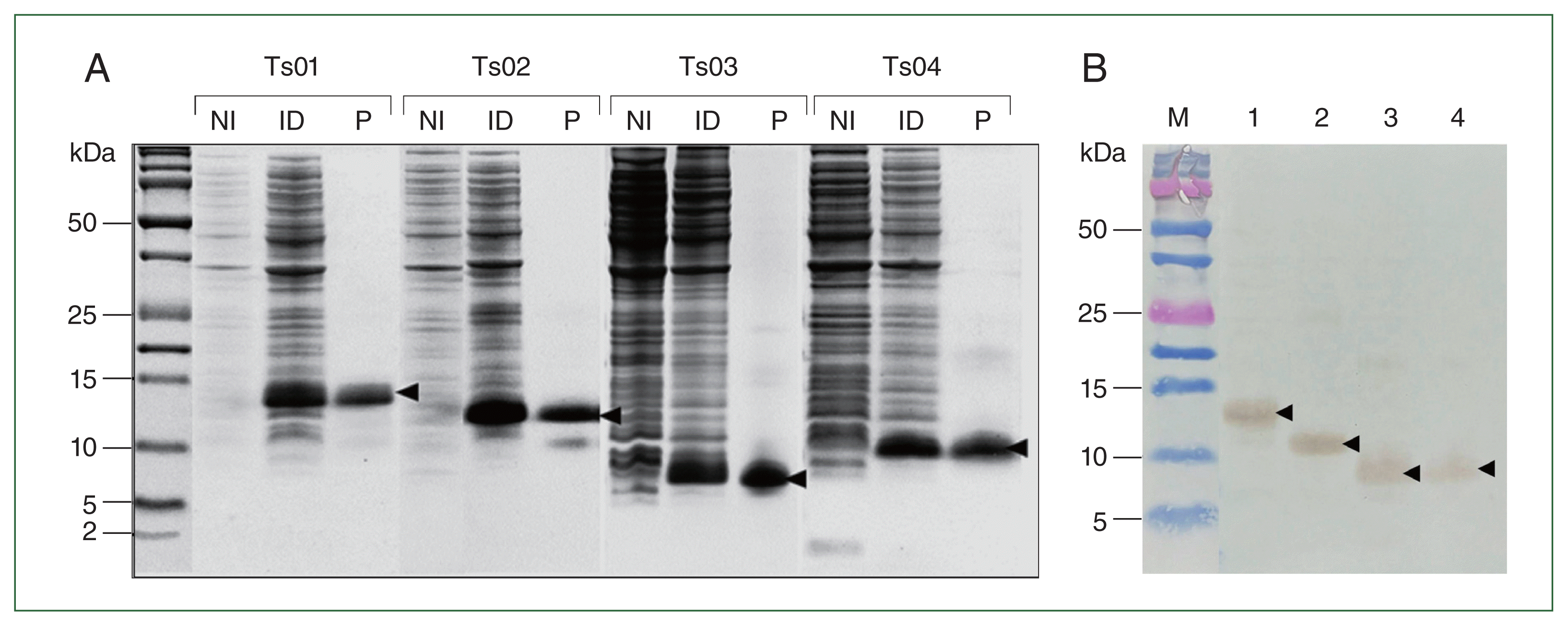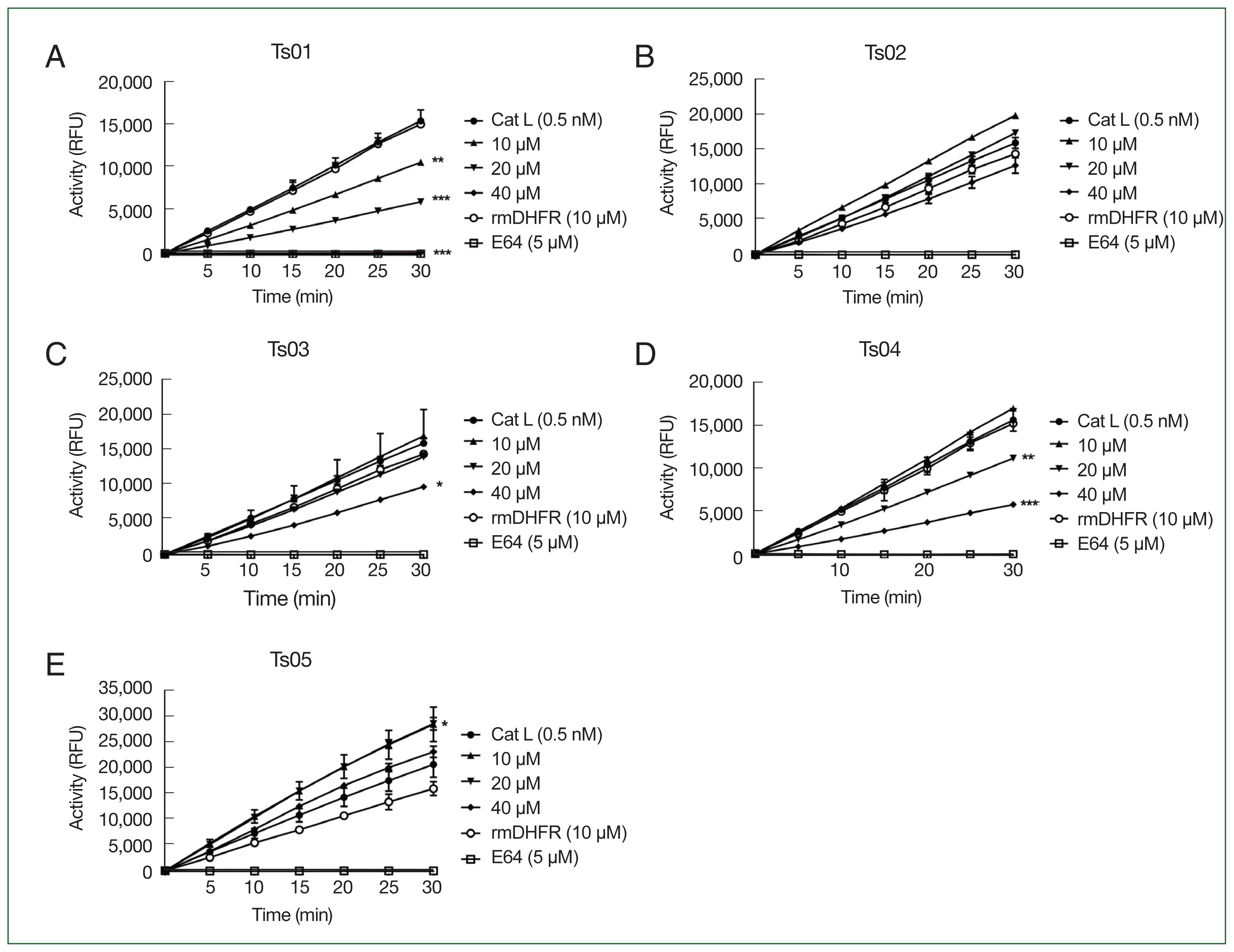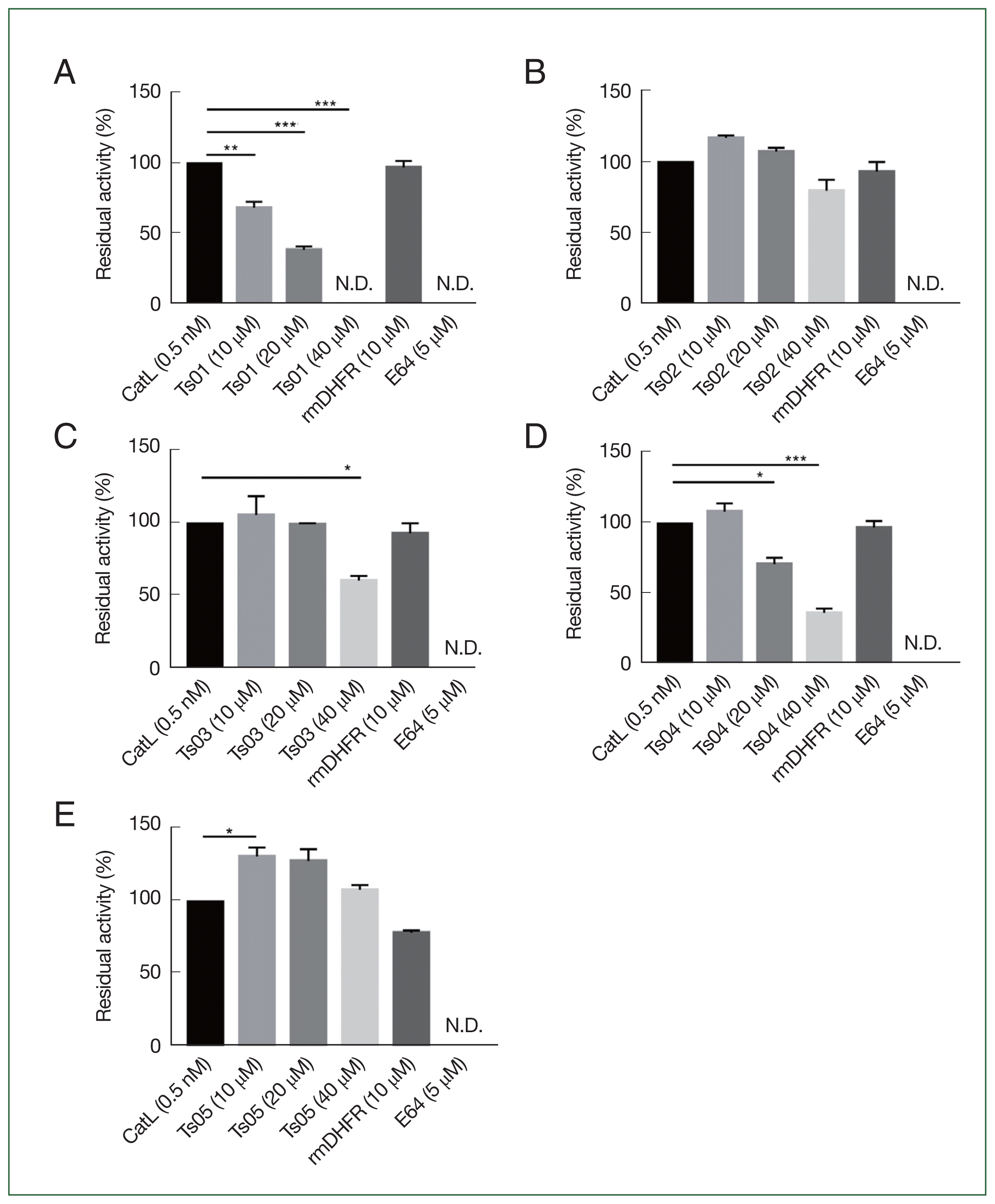Introduction
Trichinella spiralis is a zoonotic nematode that causes trichinellosis (or trichinosis) in humans and can infect various mammals worldwide [
1]. The parasite can be transmitted by consuming raw or undercooked infected meat, especially pork muscle that contains larvae (TsL1). After exposure to gastric juice in the stomach, TsL1 larvae are released from the muscle tissue and then penetrate the small intestinal wall and develop into adult worms. Adult males and females mate, after which the females release newborn larvae (NBL) that migrate via the blood or lymphatic circulation to muscles and particularly to highly oxygenated skeletal muscles [
2]. To survive long-term in their hosts,
T. spiralis larvae establish chronic infections in their host muscles by modulating and escaping potentially destructive immune responses. This is achieved by anatomical seclusion involving intracellular infection and nurse cell formation, as well as regulating host immune responses by releasing immunomodulatory molecules found in excretory–secretory products (ES) [
2,
3]. In some instances, TsL1-ES can modulate the immune response primarily through the TLR4-dependent pathway by decreasing the expression of this receptor [
4]. The incubation of TsL1-ES with HEK cells transfected with mouse TLR4 (TLR4/MD2-CD14) can suppress LPS-mediated TLR4 activation, reducing proinflammatory cytokine production [
5].
In our previous study, recombinant
T. spiralis novel cystatin (rTsCstN) inhibited the activity of cathepsin L (CatL) in vitro and ex vivo in mouse bone marrow-derived macrophages (mBMDMs). Moreover, rTsCstN exhibited anti-inflammatory properties in mBMDMs by suppressing lipopolysaccharide (LPS)-mediated proinflammatory cytokines, including tumor necrosis factor (TNF)-α, interleukin (IL)-1β, and interferon (IFN)-γ and by interfering with the antigen presentation process through the suppression of MHC class II expression [
6]. In addition, the interaction between TsCstN-mBMDMs impaired the Th1 response, affecting downstream T-cell priming by lowering IFN-α and IL-12 levels and interfering with STAT4 signaling [
7]. To achieve an in-depth understanding of properties and functions of TsCstN, the protease inhibitory domain of the protein should be identified and characterized and establish if future modifications or truncation of this protein could increase its activity and specificity against inflammatory diseases.
In previous studies, cystatin-derived peptides have been designed and used for therapeutic purposes, including anti-inflammatory, antimicrobial, and anticancer effects. The administration of peptides derived from filarial cystatin to mice with dextran sulfate sodium–induced colitis significantly reduced gross and histological pathological alterations and inflammatory responses [
8]. The N-terminal fragment of human cystatin C exhibited strong antibacterial action against several bacterial species, including methicillin-resistant
S. aureus, frequently isolated from infected wounds [
9]. A small cystatin C peptide also demonstrated anticancer effects by decreasing cell growth, proliferation, and migration and increasing apoptosis in melanoma cells in vitro [
10].
In this study, we identified the protease inhibitory reactive regions of TsCstN by using an in silico truncation modeling approach. Full-length TsCstN was employed to simulate secondary (2D) and tertiary (3D) structures before determining the truncation locations based on the functional domains of the proteins. Subsequently, recombinant proteins of TsCstN and its truncates were expressed in a prokaryotic expression system or artificially synthesized, followed by an evaluation of their properties through the inhibition of human CatL. The results of this study will help in the future development of biotherapeutic medications for immune-mediated disorders and chronic inflammatory diseases.
Materials and Methods
Ethics statement
Not applicable.
Bioinformatic approach to design TsCstN protein truncates
In our previous study, TsCstN was shown to lack conserved cystatin sequences according to multiple protein alignments with its homologs [
6]. Therefore, we gathered additional cystatins derived from various helminths to reassess the multiple alignment and validate our earlier discovery [
6]. Amino acid sequences of ten helminth cystatins were retrieved from the NCBI database (
https://www.ncbi.nlm.nih.gov/genbank/); amino acid sequences and accession numbers are provided in
Supplementary Table S1. Multiple sequence alignment was performed to compare the conserved sequence regions using ClustalX2 [
11] and visualized using the Bio-Edit alignment editor [
12].
Design of TsCstN truncates and protein structure simulation
The amino acid sequence of full-length TsCstN (Ts01) was used to determine the protein 2D structure predicted by five different programs: Jpred4 [
13], PHD [
14], Phyre2 [
15], PSIPRED [
12], and PredictProtein (
https://predictprotein.org/). The TsCstN truncates, TsCstN
Δ1–39 (Ts02), TsCstN
Δ1–71 (Ts03), TsCstN
Δ1–20, Δ73–117 (Ts04), and TsCstN
Δ1–20, Δ42–117 (Ts05), were manually designed by removing protein domains based on the 2D structures and functional protein domains of Ts01 to generate Ts02–Ts05 were subsequently predicted as 2D structures using the same programs as above for Ts01 to confirm structure change and stability after truncation; predicted structures were then aligned using the Bio-Edit alignment editor [
16]. The molecular weight and isoelectric point of Ts01–Ts05 were predicted using the ProtParam tool on the ExPASy server (
http://www.expasy.org/tools/).
I-TASSER [
17] and the AlphaFold2 method [
18] were used to simulate the 3D structure of Ts01–Ts05. The surface area, volume, and 3D structures of these proteins were visualized using Biovia discovery studio (Discovery Studio Modeling Environment, Release 2022. Dassault Systèmes; San Diego, CA, USA: 2021), and the Ramachandran plot was evaluated to verify the quality of each structure using PROCHECK analysis [
19]. Structures of truncated TsCstN were superimposed onto Ts01 using the PyMOL2 server (
http://www.pymol.org/pymol). The overall conceptual framework of protein modeling is shown as a flow chart (
Supplementary Fig. S1).
DNA amplification and cloning of truncated TsCstN DNAs
pET23b
+ carrying full-length TsCsN without a signal peptide (pET23b-Ts01) was prepared in our previous publication [
6] and was used as the DNA template for amplifying truncated TsCstN (Ts02–Ts04) DNAs. The specific primers were designed to amplify the encoding DNA region of each truncate, and the
BamHI and
HindIII restriction sites were incorporated into the 5ºC-end of the forward (fw) and reverse (rv) primers, respectively, for cloning into pET23b
+. Specific primers for amplifying Ts01–Ts04 are listed in
Supplementary Table S2. The Ts05 peptide was synthesized by GenScript (Piscataway, NJ, USA).
The truncated TsCstN was amplified via conventional PCR in a total volume of 20 μl containing 2 μl of pET23b-Ts01 plasmid (approximately 1 ng), 1× Dream Taq DNA polymerase buffer, 0.2 mm of each dNTP, 1 U of Dream Taq DNA polymerases, and 100 nM of Fw- and Rv-specific primers of each truncate. PCR conditions consisted of 94ºC for 5 min, 35 cycles of 94ºC for 30 sec, 55ºC for 30 sec, and 72ºC for 2 min and a final extension step at 72ºC for 5 min. Results were checked via 3% gel electrophoresis. The target amplicon was excised from the gel and purified using a GenepHlow Gel/PCR kit (Geneaid Biotech, New Taipei, Taiwan). The pET23b+ plasmid (Novagen-EMD Biosciences, Darmstadt, Germany) and purified Ts02, Ts03, or Ts04 amplicons were digested with BamHI and HindIII at 37ºC for 4 h before ligation with T4 DNA ligase (Thermo Fisher Scientific, Waltham, MA, USA). The ligation reaction was transformed into Escherichia coli strain JM109 via heat-shock. The following day, 5 to 10 single colonies from each plate of truncated TsCstN were selected to confirm and validate DNA recombination using colony PCR, restriction endonuclease digestion, and DNA sequencing.
Expression and purification of full-length and truncated TsCstN proteins
Recombinant truncated TsCstN, the plasmids pET23b
+ carrying Ts02, Ts03, or Ts04 (pET 23b-Ts02, pET23b-Ts03, and pET23b-Ts04, respectively) were isolated from
E. coli strain JM109, and transformed
E. coli strain BL21 (DE3). BL21 cells carrying plasmid pET23b-Ts01, -Ts02, -Tso3, or -Ts04 were used to express and purify recombinant proteins as previously described [
6]. Recombinant mouse dihydrofolate reductase (rmDHFR) was produced using the procedures outlined in our previous study and employed as an irrelevant protein control [
6].
Protease inhibitory assay
The Ts01–Ts05 proteins were evaluated for their inhibition of human CatL activity (Sigma-Aldrich, St Louis, MO, USA). rTs01 (129 μM), rTs02 (392 μM), rTs03 (243 μM), rTs04 (350 μM), and rTs05 (19.6 mM) were diluted to 10, 20, or 40 μm and incubated with assay buffer (100 mM sodium acetate, pH 5.5, 100 mM NaCl, 1 mM DTT) at 37°C for 30 min. Subsequently, the reaction was added to Nunc F96 MicroWell Black plate, followed by the addition of 0.5 nM CatL into the well and incubation at 37°C for 30 min. Then, 100 μl of ta fluorogenic CatL substrate (10 mM of Z-Phe-Arg-AMC-HCl) (Chem-Impex International, Wood Dale, IL, USA) was added per reaction. The fluorescence intensity was monitored at 37°C for 30 min using a fluorometer (Tecan Infinite M Plex, Tecan Austria GmbH Untersbergstr. 1A, A-5082 Grödig, Austria) with excitation and emission at 360 and 480 nm, respectively. The percentage of residual enzyme activity was determined. rmDHFR and E64 were used as irrelevant and positive inhibitor controls, respectively. Experiments were performed in duplicate with two independent experiments.
Statistical analysis
Statistical analyses were performed using GraphPad Prism 7 software (GraphPad, La Jolla, CA, USA). The significance between each group was analyzed using one-way ANOVA followed by multiple comparison tests. Individual data in each group are presented as the mean±SD; a P-value <0.05 was considered significant.
Discussion
Cystatins derived from parasitic helminths have been characterized as immunomodulatory molecules that affect immune responses such as the suppression of T-cell proliferation, inhibition of antigen processing and presentation in antigen-presenting cells, and regulation of pattern recognition receptors, and particularly the TLR-4 receptor on macrophages and dendritic cells, which release suppressive cytokines enabling long-term survival in their host [
21]. Our earlier research showed that TsCstN derived from
T. spiralis reduced CatL-associated inflammation [
6]. In this study, we focused on characterizing protease inhibitory regions of TsCstN to modify them into a small peptide inhibitor against excessive inflammation.
The sequence analysis of TsCstN identified a signal peptide (1–20 aa), an N-glycosylation region, and two potential disulfide bonds, which are indicated as type 2 cystatins. In our previous study, TsCstN was initially identified as a hypothetical protein, necessitating structural annotation to elucidate its potential function. The simulated 3D structure had the closest homology with human cystatin E/M (HsCstM). However, multiple alignment comparisons of the protein sequence of TsCstN with those of HsCstM and a few selected cystatin homologs through show that TsCstN lacks the conserved regions typical of type 2 cystatins. These include the absence of the glycine residue at the N-terminus, the QXVXG motif at L1, and the PW motif at L2 [
6]. In the present study, additional helminth cystatin homologs were incorporated to ascertain the presence of cystatin-conserved regions. Despite these efforts, the results remained consistent with our earlier findings, and crystallization may be necessary to determine the accurate 3D structure of TsCstN. This would provide insights into the biological function of the protein and its significance in
T. spiralis, including its role in host-parasite interactions. In previous studies, hypothetical proteins have been crystallized from parasites such as
Giardia lamblia,
Leishmania major, and
Schistosoma mansoni [
22–
24]. This approach is crucial for gaining deeper insights into their biology and for the development of effective drugs and vaccines.
To clarify the inhibitory reactive region of TsCstN, the protein truncated sites were designed based on the 2D structure of TsCstN as predicted by five different programs, including Jpred4, PHD, Phyre2, PSIPRED, and PredictProtein. Impressively, all programs predicted a similar 2D structure of TsCstN, which comprised five reactive regions: α1, L1 (β1 and β2), irregular coil, L2 (β3 and β4), and α2. Four distinct truncates, Ts02–Ts05, were generated by deleting the protein regions in TsCstN. The 2D structures of all truncates, predicted by five different programs, showed consistent outcomes, indicating that the different deletions did not affect 2D structure conformation alterations.
I-TASSER and AlphaFold2 were used to simulate the 3D structures of Ts01 and truncates. AlphaFold2 could accurately predict the full-length and truncated TsCstN protein structures with a high degree of structural similarity to the hypothesized protein. Certain truncated structures, particularly Ts04, exhibited good quality with a high percentage of favored regions. I-TASSER is a widely used technique that creates precise 3D models of protein structures by combining several approaches, such as threading, ab initio modeling, and structural refining [
17]. AlphaFold2 predicts the 3D structure of proteins by using a deep neural network architecture and advanced machine learning techniques that utilize amino acid sequences [
18]. Consequently AlphaFold2 can predict 3D structures with high accuracy and prediction compared with I-TASSER. AlphaFold, an artificial intelligence-based technique for predicting protein structures, has demonstrated remarkable accuracy in model prediction and can consistently predict protein structures with atomic accuracy, even when no comparable structure is available [
18]. Recently, AlphaFold has been extensively used in several structural biology fields, such as drug discovery, protein design, and protein function prediction [
25–
27].
The inhibitory properties of the recombinant TsCstN and truncates were confirmed in reactions against cathepsin L. Cysteine proteases, including CatB, CatL, and CatS, are involved in antigen presentation processing. CatB processes the antigen, and CatL and CatS degrade the major histocompatibility complex (MHC) invariant chain (li) in antigen processing cells, activating MHC-II formation [
28,
29]. Several studies have shown that parasite cystatins can inhibit cathepsin during antigen presentation [
21]. In our previous study, rTsCstN specifically inhibited the activity of CatL but not that of CatB or CatS [
6]. Therefore, this study focused on determining the inhibitory function of truncates against CatL. The 3D structure of TsCstN and other cystatins contains the NH2-terminal α1, L1, and L2, structures which are necessary to interact with the active site of cysteine proteases for inhibition [
6,
30]. rTs01 and rTs04 effectively inhibited CatL compared with other truncates. Thus, α1 and L1 are essential in inhibiting CatL activity, although rTs04 was less effective in reducing CatL activity than TsCstN-WT at the same dose. In human cystatin A, the NH2-terminal α1 region is involved in cysteine protease activity, and different NH2-terminal truncations cause the loss of inhibitory activity [
31]. An important role of the α1 region of TsCstN in CatL inhibition was suggested by Ts02, which lacks α1 but contains L1 and L2. This truncate lost the ability to inhibit CatL. However, the α1 alone in Ts05 failed to inhibit CatL. Interestingly, rTs05 unexpectedly increased CatL activity instead of inhibiting it. However, the cause of this increase remains unknown and has not been addressed elsewhere and will therefore be explored in future study. We conclude that the α1 and L1 regions (
Fig. 4), comprising 52 amino acid residues (DLSELDEAKNYIYQSDLQTGRGNFRKVLKVRNVDTSDGLSLTIDALPTTCPV) (
Supplementary Table S3) are sufficient to inhibit CatL, whereas L2 helps increase CatL inhibitory activity.
Importantly, while TsCstN and its truncates exhibit CatL inhibitory activity, high concentrations of these recombinant proteins are required for effective inhibition. This could be due to several factors, including TsCstN not being a specific inhibitor for CatL or potential conformational inaccuracies when expressed in a prokaryotic system. Therefore, native TsCstN must be purified to test its protease inhibitory activity. Additionally, optimizing the expression system and conducting crystallization studies should be prioritized in future work.
In conclusion, CatL activity was efficiently inhibited by TsCstN truncates, particularly Ts04, which contains α1 and L1 regions. Further research should be conducted regarding the ex vivo reduction of macrophage inflammation and in vivo anti-inflammation in animal models. Furthermore, protein dynamics simulations, inhibitor types, enzyme kinetics, and molecular docking techniques can be used to deepen our understanding of the function of these proteins.




